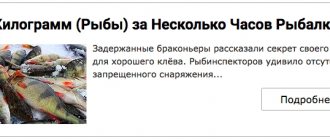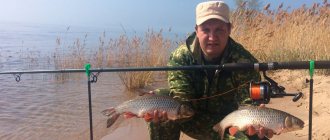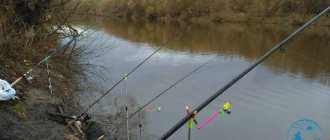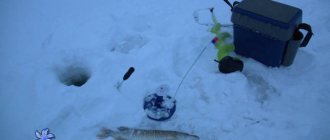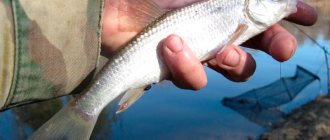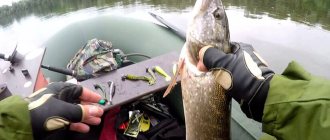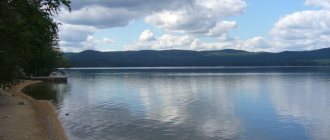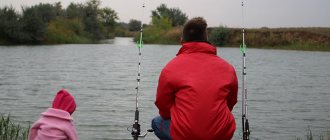- Fishing in Voronezh
- Fishing on the Don
- Paid fishing
- Fishing reports
- Fishing ban
Fishing in the Voronezh region is popular both in summer and winter. Paid fishing is quite well developed. There are fishing bases with accommodation and rangers.
Fishing in the Voronezh region
In the Voronezh region, the main river for fishing is the Don. In addition to it, there are other large rivers - Voronezh, Khoper, Devitsa, Bityug. Most of the lakes are located in the Don floodplain (Pogonovo, Kremenchug, Zhirovskoye).
In the area you can catch bream, pike, carp, catfish, and pike perch. There are sturgeons - sterlet, stellate sturgeon, sturgeon. Cupid, carp, and silver carp are raised in fisheries.
Fishing in Voronezh
In Voronezh, within the city limits and beyond, you can meet many fishermen. There are several proven places for good fishing.
Reservoir
Fishermen gather near the Vogress Bridge. There is a clean sandy beach here. It is better to catch fish with a fishing rod, but you need to cast it further away.
It is also recommended to visit the Chernavsky Bridge. There are good places underneath. You can get to the embankment by public transport or bicycle. This area is home to bream, carp, crucian carp and other representatives of aquatic fauna. More experienced fishermen recommend taking feeder gear with them. The fish bite on it more actively.
Voronezh River
If you go to Tavrovo, you need to take a boat with you, since there is shallow water near the shore. In the middle of the river there is a flooded oak grove where large carp live.
Big lake
The lake does not live up to its name; the average depth does not exceed 4 meters. The shore is overgrown with reeds and water lilies. Fishermen often come to Lake Bolshoye to catch roach, crucian carp and bream.
One of the main advantages of the reservoir is its location within the city. Experienced fishermen advise choosing other places, because mostly small fish are found here. To catch trophy representatives, it’s worth going out of town.
Fishing on the Don near the village of Medovka (Voronezh region)
Outwardly similar to Krivoborye, Medovka is attractive in many respects: not far from the city, the Don makes a loop here, in a short distance there are both steep and gentle banks with a convenient approach to the water, riffles, shallow water with a current, calm depths (after the loop).
All these advantages add up to a big minus: sometimes it seems that there are more spinners here than fish. In addition, with the opening of the swimming season, the flat area in front of the loop turns into a crowded beach. No one can fish calmly in such conditions.
Fishermen who know these places go under the cliffs, away from crowded places. There they manage to catch chub, asp, and pike perch. In winter, ice fishing gives good results for crucian carp, roach, and bleak. There are quite large pike, silver bream, bream, perch, catfish, carp and sabrefish.
It is almost impossible to predict which bait and groundbait will be most catchy on a given day. For example, in the morning a fish can greedily pounce on a “sandwich” of maggots with corn, and from lunch switch its interest exclusively to a dung worm or mollusk.
In addition to spinning, they are caught using a regular float rod, bottom gear and a feeder.
Fishing on the Don
The Don River is the largest river in the Voronezh region. More than 70 species of fish live in it and its tributaries. Fishing is especially valuable for lovers of trophies: the Don with an abundance of food allows the fish to grow to a significant size.
The winding channel and convenient approaches to the water on the left, gentle bank provide fishermen with excellent opportunities for fishing with a feeder, bottom or float rod. The right bank is steep almost along its entire length. There are many places on this side where you can go fishing with a spinning rod.
Fishing in Shilovo
The gentle bank of the Don near the village of Shilovo is one of the most popular places among fishermen. Excellent access to water and an abundance of fish easily explain the popularity of this area. Sports fishing competitions are often held here.
Bottom gear and feeder are the most popular here. They catch both from the shore and from the boat. When going fishing in Shilovo for the first time, stock up on a fast or medium-fast feeder, with a dough of 100-120 g. and feeders of 50-80 gr.
Most often caught here are roach, crucian carp, rudd, bream and bream, white-eye, and saberfish. There are biryuk, silver bream, asp, carp, and catfish. Sometimes you manage to catch chub, perch, and pike.
Fishing in the village of Krivoborye
The village of Krivoborye is located 40 km from Voronezh. Fishermen come here all year round.
The winding channel is combined here with a strong current. This must be taken into account when choosing gear. Feeder, float rod, donka are in demand.
Krivoborye village area
Among the baits, local fish prefer worms and maggots (they especially like red maggots). As bait, it is better to use mixtures of different types of purchased additives or time-tested homemade recipes.
Bleak and bream, pike perch, crucian carp, sabrefish, ram, perch, silver bream, and goby are often caught here. You come across a catfish (it’s good to tempt it with a mole cricket), and you come across a cautious asp. Having successfully stumbled upon a hole, you can catch a minnow.
Fishing near the village of Medovka
Outwardly similar to Krivoborye, Medovka is attractive in many respects: not far from the city, the Don makes a loop here, in a short distance there are both steep and gentle banks with a convenient approach to the water, riffles, shallow water with a current, calm depths (after the loop).
Fishing in Semiluki
The surrounding area of the city of Semiluki is a paradise for fishermen. It is not for nothing that there are recreation centers in the area where paid fishing is organized - Melovatka, Torbovo Estate, Seventy.
There are cozy houses where you can spend the night and just spend time with friends.
The most popular places among connoisseurs are Strelka, where the Voronezh River flows into the Don, and Semiluksky Bridge. They fish from the shore, from a bridge, on a boat, using a spinning rod, feeder, and bottom gear.
Fishing near the village of Kostenki
Kostenki is a village on the right bank of the Don, 40 km south of Voronezh. Next to it there is an archaeological museum-reserve. Excavations showed that people lived here already 45 thousand years ago.
The Don bends behind the village, and fishermen have plenty of places to roam: you can find deep holes, rapids with rapids, and backwaters near coastal bushes. You can fish from the flat bank, or from the opposite side.
Fishing in Liski
Liski is a small town 100 km from Voronezh. Both within the city and in its environs, throughout the Liskinsky district on the Don, and on its tributaries, on the lakes there are places that have long been loved by fishermen.
Experts from all over the Voronezh region and other regions of Russia come here. There are stocked ponds in the area where fishing is paid, but production is almost guaranteed.
Particularly popular are the mouths of tributaries, where small rivers merge with the Don. Avid fishermen use donkeys, feeders, spinning rods, and classic float rods.
Fishing in neighboring regions: Volgograd, Lipetsk, Tambov regions.
Following a chub through muddy water. Fishing on the rift of the Don River in the Voronezh region.
Targeted chub fishing is considered one of the most difficult types of spinning fishing. Firstly, the bighead (as the chub is commonly called in the fishing community) is a very smart and cautious fish with excellent eyesight. Having noticed a “foreign” shadow on the water, the fish becomes wary, and capture in this place becomes unlikely.
Secondly, fishing for white predators is carried out, as a rule, on rivers with fast or moderate currents, very often in cramped conditions. And such fishing requires certain skills from the fisherman. In addition, most “chub” rivers have a limited number of approaches to the water.
However, a bite from even a small specimen can easily make the fisherman’s heart skip a beat. Chub fishing is especially spectacular in the summer months, when most bites are accompanied by powerful slaps and splashes.
Anyone who has ever caught a chub knows firsthand about the powerful resistance that the fish provides when fishing. Sometimes, in order to hold several tails, a spinner travels tens of kilometers of coastline. And such fishing is not always effective. However, the landscapes that you encounter along the way can more than compensate for the lack of catch.
The nature in such places is simply mesmerizing. This is not fishing in its classical sense, where the main task is to catch as many fish as possible. This is more of a trip with a focus on spinning fishing, where, among other things, you have the chance to “fight” with a worthy opponent.
The final fishing for chub took place on one of the rifts of the Don River in the Voronezh region. The place was quite promising, but the muddy and high water cast doubt on this prospect. Mud, as you know, does not contribute to a good bite. Having lost a little optimism, my partner and I began collecting spinning rods.
This time my assistant was an ultralight-class spinning rod Zetrix Forra 602XUL in a test bottle from 0.5 to 2.5 grams. The lightest and most delicate model from the Forra “family”. This is a classic trout rod, which the developers have endowed with an additional reserve of power in the butt, due to which the spinning rod confidently copes not only with small fish, but also with larger fish.
The spinning rod is equipped with a two-thousandth DAIWA Prorex with a braided line of 0.2 diameter according to the Japanese classification. To tell the truth, such a set is too delicate for chub fishing and the fish can break a thin cord in one go. However, the choice of this set was determined not only by a passion for “thrills”, but also by the baits used. In addition to the chub classics (wobblers, micro-oscillators), the use of jigs was not excluded.
Of course, a more powerful braid would be most appropriate here: 0.4 – 0.6 PE. And a spinning gram up to 7 of the upper test (medium or fast action) will allow you to “cover” the main weights of the micro-oscillators used.
When using such a delicate set, you need to be aware of the likelihood of unfortunate derailments and possible breaks with subsequent loss of baits. This tackle is justified by the strong adrenaline rush and the pleasure received from fishing with such a light fishing rod. Looking ahead, I will say that the tackle did not let me down. And I coped with the fish, and the jigs were more useful than ever. But first things first.
When fishing for chub on a spinning rod, the most common baits are small wobblers (for example, the well-known and respected Dzhakalovsky chabik in chub fishing circles), oscillating and rotating spoons.
More precisely, it would be more correct to say “spinners”, because the size of the “pieces of iron” is not large, and their weight, with rare exceptions, exceeds 4-5 grams. Exceptions may occur when fishing from a boat in deep water. We are talking about shallow water riffles, where 2-3 grams of spinners will be more than enough.
As practice shows, the use of wobblers is most important when the chub is active. In other cases, better results can be achieved with micro-oscillators and rotating spoons of zero size according to the Meps classification.
As mentioned earlier in the text, the water in the river is muddy, and therefore we could not count on the activity of the “redfin”. The depth at the fishing spot barely exceeds one meter. For these reasons, I gave preference to micro-oscillators and stuck with them until the end.
When fishing with oscillating spoons, it is important to “guess” two main parameters: weight and fishing horizon. In muddy conditions, the color of the bait (in my opinion) does not play a special role. Since the ability to perceive through the organs of vision deteriorates, the chub orients itself mainly along the lateral line. That is why the speed and horizon in which the bait moves will be much more important than its color. Perhaps acidic colors have a positive effect, but I didn’t notice it on this fishing trip.
Chub rarely remain indifferent to bait slowly moving in the pelagic layers. Therefore, a spinner that is best suited for these fishing conditions must have good aerodynamics (so that with a light weight we can throw it to the desired place) and active play on the slowest retrieve.
One of these spinners deserves special attention. It stands out for its not quite standard shape and has a wide front part, with a distant center of gravity and a narrowed “tail”. Like an iris petal, the spinner has an S-shaped bend, due to which the flight qualities reach aerobatics. The sweeping play on the retrieve and the dribbling-style shedding during pauses simply leaves no chance for both active and very passive fish, and not necessarily predatory ones. The potential of the oscillator is enormous! And at the same time, the angler’s chances of a good catch are great. Without a doubt, the Iris from SV Fishing Lures deserves the title of Prima Donna among ultra-light oscillating spoons. It was to this bait that I owe the positive emotions that accompanied me while fishing on a riffle, which did not promise anything good.
The chub did not show itself for a long time. My partner and I were pretty tired from uselessly walking up and down the current and “rinsing” the baits. We used tiny wobblers, handmade lures, and expensive “Noris” baits, but for the “losty” all our sophistications were “up to the lantern.” However, Roma managed to lure the “tongue” out from under the wall of reeds, while I remained out of work.
At such moments, it is always better to take a break or try with all your might to get away from zero as soon as possible. Otherwise, with each empty cast, disappointment and nervousness will only increase. There was no time for rest, so I decided to take a little break and “drive” all sorts of small things with a jig.
The fingerlings grabbed a 0.25 shot with half an inch worm for the sweet soul. On each cast I had 2-3 bites, and on every third cast I pulled out a fish not much larger in size than the bait itself.
Moving downstream, I sent the jig into small gaps between the reeds and on one such cast, the bait was attacked by a tiny chub. This was a sure sign to return to the spinner again.
The choice fell on a gram Air spinner, with which I have always been good at catching rudd and other peaceful fish. Since the fish were biting very small, I decided to use this spinner.
Just like Iris, this bait serves as a good provocateur for passive fish. And in this case, I relied heavily on its ability to “hang” in the water column like suspension. But upstream wiring turned out to be ineffective. By changing the direction of casting, I immediately get a dynamic bite from the “nano” asp. The fish attacked the spinner with a splash, so quickly that I even flinched! J The small “trophy” was in his hands and the feeling of hopelessness was replaced by tenderness.
It just so happens that when Air is in action, this spinner always brings at least one fish. So this time I managed to preserve this good tradition, and therefore, with a “peace of mind”, the spinner returns to its “rightful place” in the wallet.
There was very little time left for fishing, so the priority still became the search for chub rather than persistent “shelling” of interesting points. In conditions where time is limited, dynamic fishing is especially important. That's why Iris is back on the clasp in FG13, weighing 1.8g.
Even in coastal spinning competitions, intermediate weights helped me out more than once. Remembering how the perch reluctantly reacted to gram weights and how the situation changed with the 1.2 gram weight, I decided to apply a similar trick to the chub.
The tactics were as follows: three casts up stream: to the left wall of the reeds, to the right and in the center. Casting downstream was carried out using the same principle. If there are no bites, I move further, about five meters downstream and repeat the algorithm.
I carried out the wiring against the current as slowly as possible, periodically stopping the reeling. At the same time, be sure to ensure that the cord is tight. Thus, the bait played due to the current, without my active intervention.
On the next wiring, already before the spill, at the border of the stream, I felt a powerful and unexpected blow. Splashes appear on the water, the clutch begins to sing, and the spinning rod bends into an arc, clearly demonstrating its structure. A moment later, the long-awaited chub is in my hands.
The fish is not large at all and it still needs to grow and grow to trophy size. But as I said at the beginning of the article, due to the very delicate tackle, this baby seemed like a real giant. It is for these sensations that I love ultralight gear. Playing on the verge of a foul only adds adrenaline. And the taste of victory is doubly sweet.
Of course, in competition conditions, I would not neglect the additional power reserve; every fish is worth its weight in gold. But in amateur fishing, the trophy is not as important as the emotions from the time spent on the water. And if the tackle is really high-quality, then with the help of fine-tuning the friction brake and the “sticky” rod, annoying slips can be completely avoided. The jaw of a chub is not as hard as that of a pike perch and it does not require much effort to “break through” it.
After this fishing, the conclusion suggests itself: catching chub in muddy water is not only possible, but also necessary. Of course, such conditions make fishing very difficult, and to say that such fishing is difficult is to say nothing. But the more valuable a fish is, the more effort is put into catching it.
Author: Valery Melnikov
Paid fishing in the Voronezh region
Fishermen who love comfort can visit paid recreation centers. The Voronezh region attracts with its nature and picturesque views. Below are the most popular and popular places for a relaxing and comfortable holiday:
- Fishing "At Zvyagin's". The base is located in the Semiluksky district, in the village of Zemlyansk. The pond attracts with its landscaping and cleanliness. Here you can relax, take a break from the bustle of the big city. Families with children often come here. There are no restrictions on fishing on Golovishchensky Pond. Representatives of large sizes are often found here.
- Pond "Steep Log". This is a picturesque and beautiful place where people often come not only to fish, but also to relax from everyday work. The pond has an area of about 12 hectares. This place attracts with its springs. It is located 80 km from the city of Voronezh, in the village of Priobretenka. There are large fish in the pond.
- Recreation center "Golden carp". Tourists who have already come to this place leave positive reviews. There is not only good fishing here, but also a comfortable holiday for the family. There are comfortable rooms on the territory of the base. Trophy representatives of aquatic fauna live here - catfish, carp, carp and others. For fruitful and productive fishing, platforms are equipped and tables are provided.
If you choose paid recreation centers for fishing, you can treat yourself to additional services. Many places have equipped beaches where you can swim and sunbathe. Often there are cafes or restaurants on the territory of the base.
To go fishing in the winter, you can choose places with steam rooms and Russian baths.
Fishing on the Don in the village of Krivoborye (Voronezh region)
The village of Krivoborye is located 40 km from Voronezh. Fishermen come here all year round, choosing sunny, fine days.
According to some reviews, fishing here is not much different from fishing on the Don directly near the regional center. But there are those who are sure that this is the best possible place. The main thing is to arrive and settle down before dawn, when the fish are most active. An excellent option for the summer is to arrive at night, set up a tent and be fully prepared by the first rays of the sun.
The winding channel is combined here with a strong current. This must be taken into account when choosing gear. So, a feeder rod is recommended as a medium class, a feeder - 80 g. and more.
Paid fishing spots
Paid fishing in Rostov-on-Don differs from regular fishing in that there is no need to worry about taking the necessary equipment and getting bait. In these places, everything is available for rent, and the necessary conditions for a comfortable stay are created. In addition to paid bases on the Don itself, in Rostov there are paid lakes and ponds. They are periodically stocked with fish, updating not only the stock, but also the assortment.
Mostly when stocking they use:
- carp;
- grass carp;
- silver carp;
- perch;
- pike perch, etc.
Wonderful Lake enjoys very good reviews among visitors. You can easily catch crucian carp, pike perch or carp here. But to catch a pike you need to work hard. In Rostov-on-Don, fishing on paid reservoirs pleases with abundant catches. You can go fishing for a reasonable fee, for example, at the New Vasyuki base (Mokry Sambek river), on the Manych River (Portoflot recreation center) and in many other places.
Paid reservoirs
It would probably be even strange if the Rostov region differed from others in the absence of paid fishing places on its territory.
You, dear reader, have already guessed that there are such places in this region, and in considerable quantities, which, by the way, is very good, because in addition to the opportunity to go fishing, you can:
- Stay overnight at the base, living in comfortable and modernly equipped rooms;
- Having paid for the “entry ticket” you can use the grill for cooking fish and the boat for catching it;
- Rent additional summer houses for entertainment during the day;
- Buy and rent fishing equipment;
Spinning fishing on the Don
Spinning fishing on the Don is becoming very popular among anglers. With this equipment you can successfully hunt for perch, pike perch, and often catch asp and chub. I have fished with a spinning rod many times with small spoons and jig baits, but I was more successful with a retractable leash. Most often the catch includes medium-sized perch, asp, and pike perch. Quite often there are people who like to catch chub using small crank wobblers.
Catching pike perch on the Don is the main attraction for spinning enthusiasts. Indeed, comfortable living conditions have been created here for this fish - a sandy bottom with stones, shell islands, shallow water. Catching a 2-kilogram pike perch on a spinning rod is good form. There are days when even the perch are inactive. When going fishing with a spinning rod along the Don, you should stock up well on spare baits, since stones and snags are often found at the bottom. It won’t be difficult to leave your favorite wobbler or spinner here!
The best places for fishing on the Don River
In the Voronezh region, the most favorite and fruitful fishing spots on the Don are:
Gremyache village
It is located thirty-five kilometers from Voronezh.
Fishing Features:
- the ability to catch almost all species;
- Mostly small fish are found;
- the current is not strong.
Excellent bite:
Anglers should pay attention to the bait; it is more effective to constantly experiment. It has been noted that sometimes an excellent bite is provided by a worm or maggot, and on another day it can be dough or bread.
Krivoborye
It is located forty kilometers from the regional center.
Fishing Features:
- It is better to fish at dawn;
- winding river bed;
- In many areas there is a relatively strong current.
Bites well:
It is better to fish with float rods or a feeder; the equipment must be strong enough. A variety of baits can be used, but it has been noted that worms, maggots or frogs are better.
You should pay attention to trophy specimens, which can be easily caught in this area, the main thing is to use fairly strong trolling.
Fishing for large fish - Voronezh region. – Ramonsky district – village of Krivoborye – Bald Mountain – r. Don
So, it’s a day off, everyone is busy with their own business, which means there’s time to hit the river and leave the spinning rod. In view of the fact that this day is Sunday, a decision was made to go away from civilization and its loud representatives, who have become too widespread lately, in the status of vacationers.
The Don, unlike small rivers, is only saved by its muddy water and fast current below Lysaya Gora in the village. The war from the invasion of these “representatives” and their “exhaust” – i.e. garbage.
The decision was made to go to the site immediately behind Lysaya Gora (downstream). At this point the river completes its 180º turn and flows near the shore as on a mountain river. Immediately before reaching the straight section, a ridge formed in the water behind which a small hole began. Due to the topography of the shore, it is not possible to throw into a hole and you have to stand directly opposite it and throw a little lower, where the depth no longer exceeds 1.5 meters. In such a place, fishing for large fish could be successful.
Where I cast, close to the shore, I regularly caught some small racketeer fish of 1-2 kilograms, most likely pike perch. In an hour I tried jigs, spinners, and spinners. Then I decided to put my old Chinese fighter - a wobbler under the perch. I wanted to find a photo of it on the Internet - but this is apparently a secret Chinese development. The wobbler had previously been marked several times by pike teeth, so it had every right to try. I cast, cast the bait another 10 meters downstream and begin reeling. It should be noted that the wobbler itself, when reeling in, causes frequent and fairly strong amplitude oscillations, and in such a current the wiring had to be made quieter than a turtle. Opposite the place where that robber was hunting, I pause for 30 seconds; the wobbler, under the influence of the current, continued its oscillations. I start reeling in and then I feel something between a blow and a strong pull.
And then something started. I reel in a meter - the fish reels in 3 meters, sometimes it stays in place and I just can’t move it. At the same time, that villain still continues to chase change, clearly something else is on the hook. 10 minutes of tough struggle, the spinning rod is arcing, the braided line is ringing, I am drenched in sweat and just praying that either the fishing line doesn’t break or the spinning rod doesn’t break. You could even say to yourself that it would break faster :). Very quickly I began to feel my back numb, I managed to squat down, and even managed to light a cigarette. And the fish felt like it didn’t feel tired at all by that time, the jerks didn’t become any weaker. The entire fight took place underwater, and this monster never bothered to surface to even show itself briefly.
Here followed a series of strong jerks, and then... ding - the carabiner clasp on a leash made of rather thick wire unbent, which you bend with great difficulty even with your hands. My grief knew no bounds. Then, together with the fishermen, we decided that it was most likely a 10-20 kg catfish or a large pike perch.
After that, I went to this place 3 more times, but there was silence on the river and I didn’t catch anything except a small chub on Kosadaka; catching large fish is no small matter in almost any weather.
After this fishing, I couldn’t understand myself, why on the current where there are no pikes, and even put a leash on the braid? I don't know, maybe it's automatic. And in conclusion, some photos of those places. By the way, you can see how a kilometer-long beach is being removed for road repairs, now they say it’s already empty.
